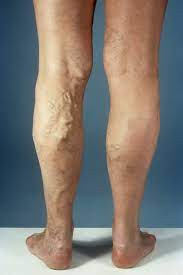Definition
Esophageal varices are abnormal dilations of the veins that occur in the esophagus. These veins carry blood from the esophagus to the portal veins in the liver before entering the main venous return and heading toward the heart. Typically, this condition occurs in patients with severe chronic liver disease that has progressed to liver hardening and the formation of scar tissue, known as cirrhosis.
Causes
Esophageal varices are caused by high pressure in the liver's portal vein. This elevated pressure can result from various factors, including:
- Blood clots within the vein.
- Scar tissue formation in liver disease, which compresses the blood vessels.
- Parasitic infections affect the liver.
- Increased blood flow to the portal blood vessels.
The portal vein in the liver lacks valves to prevent blood backflow, allowing high-pressure blood flow into the preceding blood vessels. This can also occur in the veins in the esophagus area. The backward flow increases pressure on the esophageal veins, enlarging them.
In response to this pressure, blood may flow through smaller vessels in the esophagus. However, these vessels have limited capacity to accommodate excessive blood flow, and, consequently, they can rupture.
Risk factor
Individuals with severe and prolonged liver disease can develop esophageal varices, and some are at higher risk of bleeding due to the rupture of blood vessels in the esophagus. These individuals include:
- Those with sufficiently high portal blood pressure.
- Individuals with large-sized varices in the blood vessels.
- Those with varices exhibiting red spots when viewed using an endoscope (a tube-like device with a camera at the end, inserted through the mouth).
- People with a history of previous esophageal variceal bleeding.
- Patients with advanced-stage liver disease.
In individuals with liver disorders, the severity of the liver disease correlates with the risk of variceal rupture. Having cirrhosis and liver failure increases the risk of bursting varices.
Excessive alcohol usage can lead to fatty liver and liver hardening, which can elevate portal blood pressure, trigger variceal formation, and increase the risk of variceal rupture.
Symptoms
Unruptured varices typically do not cause symptoms. However, if the varices rupture, several symptoms may appear, including:
- Fresh blood vomiting in large amounts
- Black or bloody stools
- Discomfort in the abdomen
- Muscle cramps
- Itching on the body
- Feeling lightheaded and severe cases can lead to decreased consciousness
Additionally, signs of liver disease may include:
- Yellowing of the skin and the white part of the eyes (jaundice)
- Easy bruising or bleeding
- Fluid accumulation in the abdomen due to decreased fluid retention in blood vessels (ascites)
- Weight loss in individuals with chronic liver disease
Diagnosis
Ruptured esophageal varices constitute an emergency condition. In the emergency department (ED), medical professionals prioritize stabilizing the patient's condition and administering specific treatments and intravenous fluids if stability has not been achieved. Once the patient is stable, an abdominal examination is conducted to assess for abdominal masses or fluid accumulation. Additionally, signs of other liver diseases may be assessed, as they can sometimes be visible on the skin.
Laboratory tests, including a complete blood count, are often performed to check for anemia due to blood vomiting and decreased platelet levels. Other tests may include liver enzymes, alkaline phosphatase (ALP), bilirubin (a substance that causes the skin to yellow in individuals with certain diseases), blood clotting time, and blood protein levels. Further tests may encompass urea and kidney function tests, blood electrolyte levels, blood gas analysis, and tests to detect hepatitis virus infections.
In advanced healthcare facilities, endoscopic examination can be conducted to locate and close the source of bleeding. This endoscopic procedure, esophagogastroduodenoscopy (EGD), allows for direct visualization of the varices. If endoscopic equipment is unavailable, computed tomography (CT) scans or magnetic resonance imaging (MRI) can be utilized to identify enlarged and ruptured blood vessels. Contrast agents may be used in imaging to clarify the position of the ruptured blood vessels. Ultrasonography (USG) can also detect these blood vessels, particularly Doppler ultrasonography.
Management
Treatment for bleeding esophageal varices involves several steps. Intravenous fluid replacement is administered to replace the lost blood and maintain blood pressure. It is also important to ensure the patient remains conscious to differentiate the condition from other liver disease complications, such as hepatic encephalopathy, which can cause decreased consciousness.
Medications are often given to reduce pressure on the portal blood vessels. If available, the bleeding source may be closed, which can involve clotting the surrounding tissue or clipping the blood vessels. Antibiotics may also be administered to prevent infection in esophageal wounds.
Surgery may be an option to address esophageal varices. This may involve partial removal of the esophagus, liver transplantation, or the creation of shunts or specialized pathways between the portal blood vessels and other blood vessels.
Additionally, therapy is needed to manage or prevent the worsening of the underlying diseases causing esophageal varices.
Complications
Complications of esophageal varices can include:
- Rupture of varices, which can lead to blood entering the respiratory tract and causing:
- Choking
- Shortness of breath
- Death
- Multi-organ failure
- Perforation of the esophagus which can also result in death due to various causes.
Additionally, individuals who have experienced variceal bleeding before are at higher risk of experiencing a similar event in the future.
Prevention
If you have liver disease that has progressed to liver hardening (cirrhosis), preventing esophageal varices becomes very challenging. However, various medications can help reduce the risk of variceal rupture. Therefore, the best approach to preventing esophageal varices is by preventing liver disease altogether. Here are some steps you can take to prevent liver disease:
- Avoid alcohol consumption. Individuals with liver disease are advised to quit drinking alcohol, as it can stress the liver, which is responsible for processing alcohol.
- Eat a nutritious diet. Consume a diet rich in vegetables, fruits, whole grains, and lean protein sources such as fish and poultry. Reduce consumption of fatty and fried foods, as they can contribute to liver damage.
- Maintain a healthy weight. Excess body weight can lead to excess body fat, damaging the liver. If you are overweight, losing weight is recommended.
- Use chemicals cautiously. Follow instructions provided on household chemical products such as cleaners and insecticides. If you come into contact with chemicals at work, adhere to safety instructions to minimize liver stress from toxin exposure.
- Reduce the risk of hepatitis. Avoiding repeated use of needles or sharing needles with others, as well as practicing safe sex, can help reduce the risk of hepatitis B and C. Consider undergoing screening for hepatitis A, B, and C infections or receiving hepatitis A and B vaccinations. Hepatitis B vaccination is included in government programs for children and high-risk adults, while hepatitis A vaccination is not mandatory but can be obtained at certain healthcare facilities.
When to see a doctor?
If you experience signs and symptoms of liver disease, such as yellowing of the skin and sclera, it's important to see a doctor promptly. If you're already receiving treatment for liver disease, you can discuss the risk of developing esophageal varices with your doctor and inquire about measures to reduce this risk. You can also ask about examinations to detect esophageal varices.
if you already have esophageal varices, seek immediate medical attention if you experience signs and symptoms of variceal rupture. Ruptured esophageal varices constitute an emergency condition and can be potentially deadly.
- dr Hanifa Rahma
Esophageal varices - Symptoms and causes. (2021). Retrieved 26 January 2022, from https://www.mayoclinic.org/diseases-conditions/esophageal-varices/symptoms-causes/syc-20351538
Khan, A. (2021). Esophageal Varices Imaging and Diagnosis: Practice Essentials, Radiography, Computed Tomography. Retrieved 26 January 2022, from https://emedicine.medscape.com/article/367986-overview
Meseeha, M., & Attia, M. (2021). Esophageal Varices. Retrieved 26 January 2022, from https://www.ncbi.nlm.nih.gov/books/NBK448078/












